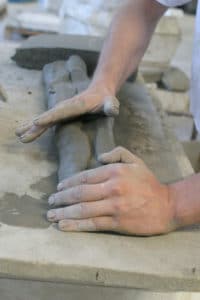Terra Incognito: The Method Behind the Form
There are various forming methods than can be used when working with clay. As a self-proclaimed clay nerd, I can tell you that one of my favorite parts of the journey is actually forming the piece. There is a “form” and there is a “surface” and if you learn to treat the two as separate aspects of the same whole, you will have a successful composition. In ceramics, there are many ways to form something from clay. For example, a piece of clay can be thrown on a potter’s wheel, press molded, slump molded, pinched into shape, coiled, built with slabs or extruded.

For this article I want to focus on just three forming methods: Throwing, Press Molding, and Coiling.
Throwing
To “throw” is to form clay using a potter’s wheel. As the clay spins on the wheel it is then “lifted” into shape. This is a very popular method, usually used to fashion functional or utilitarian pieces, such as plates, cups, bowls, teapots, or containers.
The word “throw” comes from the old English meaning to twist, turn, or propel—a perfectly apt definition. The potter’s wheel is a relatively new invention in the 30,000 year history of ceramics, and not used by all clay cultures. Much of the Greek pottery at Eye of the Day is wheel thrown.
Press Molding
Press Molding is when a piece of clay is actually pressed into a mold or form. The mold is made from an original form which is made from clay, then reproduced in Plaster of Paris, which becomes the mold so the shape can be replicated over and over again. This is a particularly helpful method when forming large pieces that would otherwise be hard to reproduce. The Italian terracotta carried at Eye of the Day is traditionally press molded.
Coiling
Coiling is one of the oldest methods for forming clay. The material is rolled back and forth until it looks like a “rope” of clay. You begin with a shape in mind, then the coils are placed on top of each other until the desired shape is formed. This is a particularly slow method, the clay needs to harden a bit before more coils can be stacked, so a potter will begin one piece and then move to another to begin, then move to another, and so on. By the time he has begun say the fourth or fifth shape, the first one will be stiff enough to continue the next phase of the shape.
Eye of the Day has an array of vessels produced using each of these traditional methods, authentically manufactured and imported directly from the very best potteries of the world.






Leave a Reply